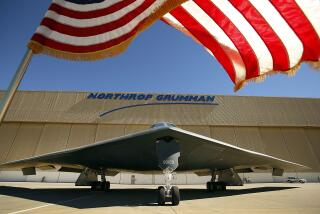Combined Missile Unit May Employ 40% Fewer Workers : Merger: Hughes officials say streamlining and business decline may result in the elimination of 7,000 jobs when the divisions are combined.
- Share via
SAN DIEGO — Streamlining and an anticipated loss of business in the combined Hughes Aircraft-General Dynamics missiles unit could end up costing 7,000 workers their jobs, or 40% of the 16,000 total, Rep. Randy (Duke) Cunningham (R-Chula Vista) said Wednesday.
The number of jobs in jeopardy--about 1,000 more than the companies previously said were endangered--illustrates the restructuring taking place in the defense business in general and in the missiles industry specifically.
Earlier this month, Hughes said it would pay $450 million for General Dynamics’ missile operations. Included in the sale is General Dynamics Convair cruise missiles unit in San Diego, which employs 4,500. Hughes then said it would consolidate its missile operation with General Dynamics’ but did not say where.
Soon after the announcement, Hughes said in an employee newsletter that 5,000 to 6,000 jobs in the new, combined unit could be lost through the consolidation, a spokesman said Wednesday. Most of those job cuts are attributable to the termination of weapons programs expected over the next year or two.
Cunningham said Hughes Aircraft officials told him in a Wednesday meeting in Washington that a cut in workers of up to 40% would be necessary to deal with the defense spending downturn and to make the new Hughes missile operation competitive, particularly against industry leader Raytheon Corp.
Cunningham and Rep. Duncan Hunter (R-Coronado), members of San Diego’s congressional delegation, requested the meeting with Hughes Vice President William Merritt and others to learn about Hughes’ plans and to see whether San Diego officials could offer incentives to keep the General Dynamics Convair jobs from leaving town in a consolidation.
On Wednesday, Hughes Aircraft said it soon will appoint a director to oversee a study on how to combine the two companies’ operations. A decision on whether jobs will be kept in San Diego will be made in six to eight weeks, Hunter said.
Other sources familiar with Hughes’ preliminary plan, however, say that a move of most if not all Convair jobs from the city is highly likely because it is the only way the proposed merger makes economic sense.
Although Hughes did not discuss specific consolidation plans in the Wednesday meeting, both congressmen said after the talks that, based on the comments of Hughes officials, chances appear slim that Hughes will keep the Convair missile jobs in San Diego because costs are significantly lower in Tucson.
The long-term solution to keeping manufacturing in San Diego, Hunter said, is to develop laws that make San Diego and California more “business-friendly.”
The Hughes announcement May 11 put 4,500 local General Dynamics Convair missile jobs in limbo. Of those, 2,500 were slated for termination in August, 1993, when the Advanced Cruise Missile program ends. The remaining 2,000 Convair jobs are related to the Tomahawk cruise missile, a program that runs through 1995.
More to Read
Inside the business of entertainment
The Wide Shot brings you news, analysis and insights on everything from streaming wars to production — and what it all means for the future.
You may occasionally receive promotional content from the Los Angeles Times.










